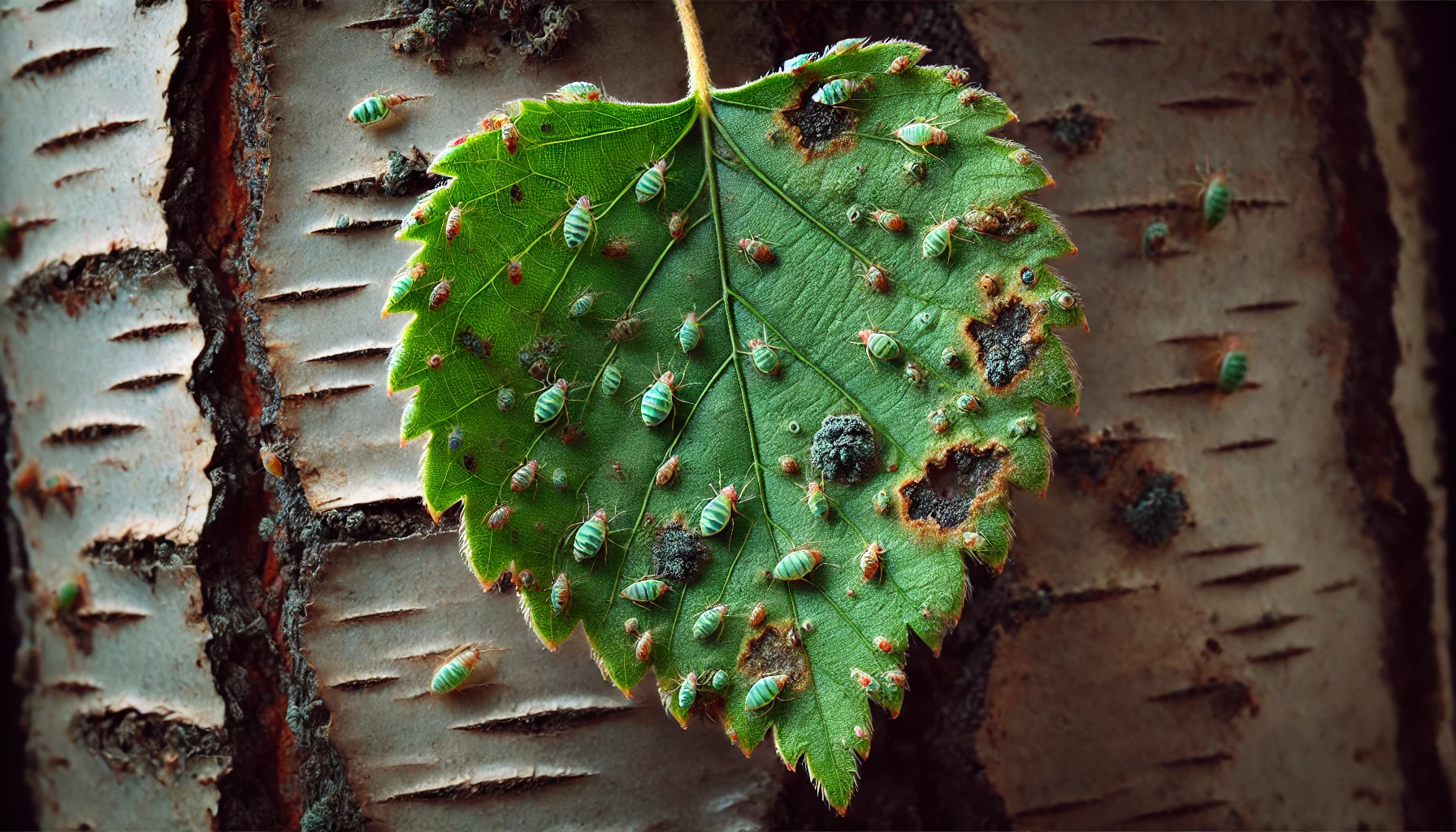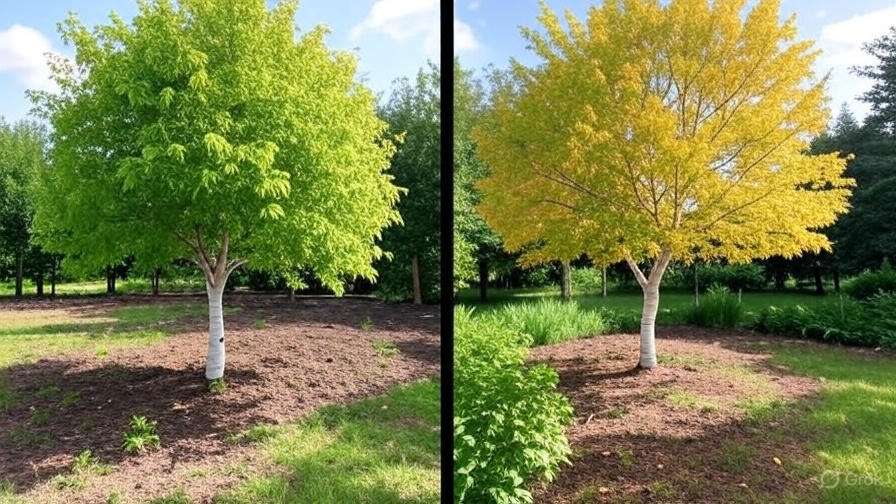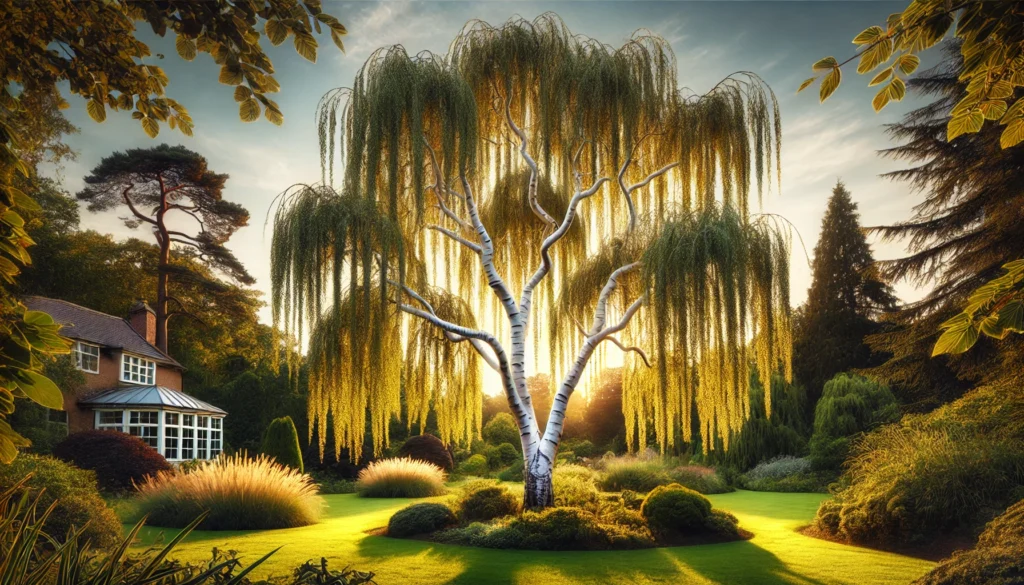
How to Care for Weeping Birch Trees: Essential Tips for Healthy Growth and Longevity
Weeping birch trees are a stunning addition to any garden or landscape, with their elegant drooping branches and beautiful white bark. 
The good news? Caring for these graceful trees isn’t as complicated as it may seem. With a few simple, expert tips, you can ensure your weeping birch thrives and adds curb appeal for years to come. In this guide, we’ll walk you through the essential steps to keep your trees healthy, vibrant, and long-lasting. Whether you’re a first-time gardener or a seasoned landscaper, you’ll find practical advice that works. Ready to nurture your weeping birch trees to their fullest potential? Let’s dive in!
Table of Contents
TogglePlanting Weeping Birch Trees: Starting Off Right 
Weeping Birch trees are stunning additions to any landscape, known for their graceful, drooping branches and striking white bark. But to ensure they thrive, planting them correctly is key! Here’s how you can give your tree the best start:
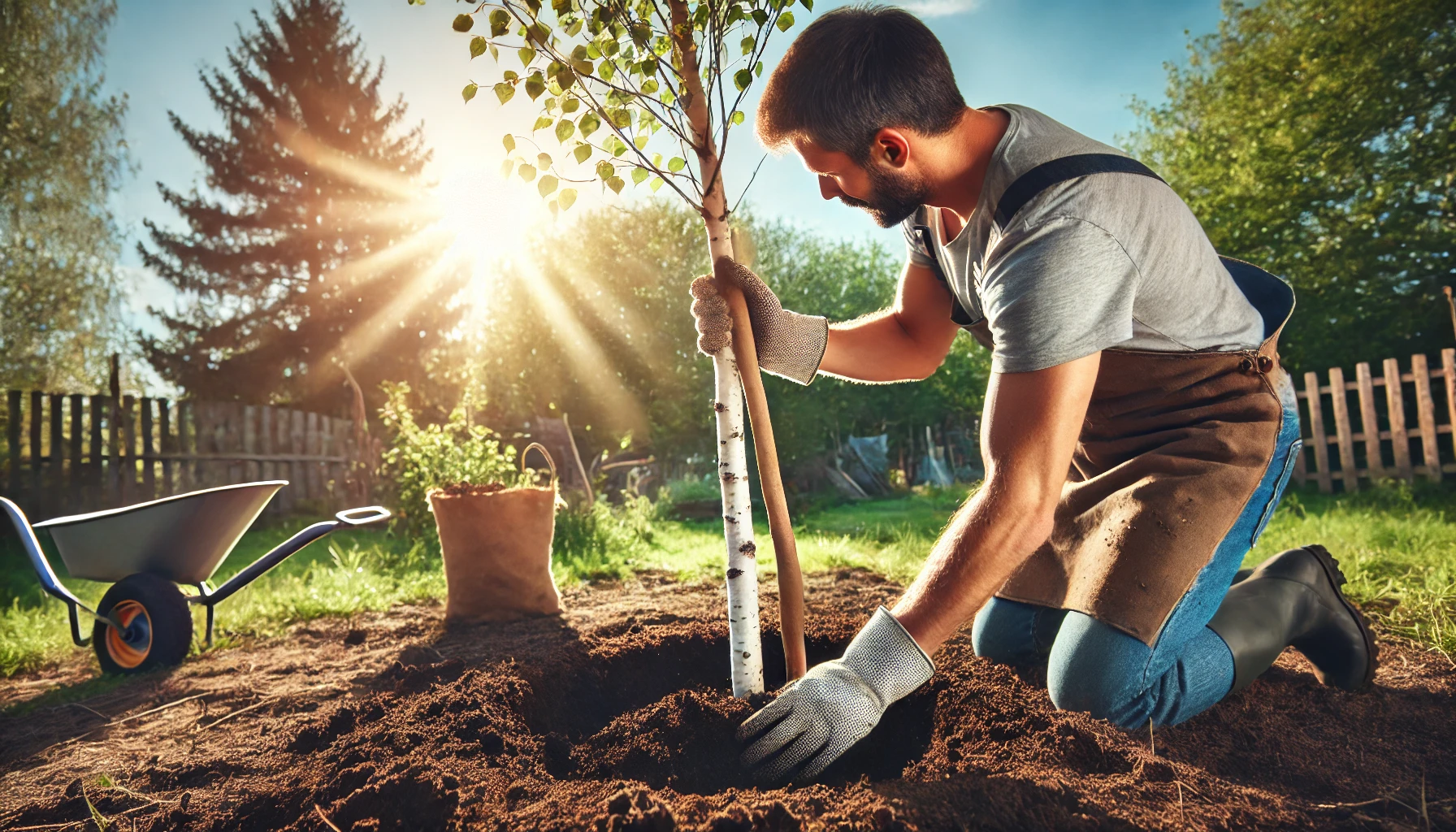
1. Choose the Perfect Location 
Weeping Birches love full sunlight, so pick a spot where they can soak up at least 6 hours of sunlight each day. Avoid areas that stay too damp or have poor drainage. These trees prefer well-draining, slightly acidic soil, so make sure the ground isn’t soggy or waterlogged.
2. Digging the Hole 
Make sure to dig a hole that is twice as wide as the tree’s root ball but no deeper than its height. The goal is to give the roots plenty of space to spread out while ensuring the top of the root ball remains level with the ground. If you plant it too deep, the tree may struggle to grow.
3. Prepare the Soil 
Loosen the soil in the hole and mix it with organic compost. This helps improve drainage and provides your tree with the nutrients it needs to get started. Avoid adding too much fertilizer at this stage—just a little will do.
4. Planting the Tree 
Place the tree gently in the hole, ensuring it’s straight. Fill the hole with the soil mixture, packing it down lightly as you go to eliminate air pockets. Be careful not to bury the trunk. Once planted, water it well to settle the soil around the roots.
5. Watering Immediately 
After planting, water your Weeping Birch thoroughly. The roots need moisture to establish themselves, but don’t overdo it! Water once or twice a week, depending on the weather, until the tree is well-established (about one to two years). During the summer, keep the soil moist, but let it dry slightly between waterings.
6. Mulch for Protection 
Apply a 2-3 inch layer of mulch around the base of the tree. This helps retain moisture, keeps the soil temperature stable, and prevents weeds. Be sure to keep the mulch a few inches away from the trunk to avoid rot.
7. Staking the Tree (If Necessary) 
If your Weeping Birch is small or in a windy spot, you may need to stake it temporarily. This helps it stay upright while its roots take hold. Use soft ties and remove the stakes after one growing season.
By following these easy steps, you’ll give your Weeping Birch tree a solid start, ensuring it grows strong, healthy, and beautiful for years to come!
Watering Weeping Birch Trees: How Much Is Enough? 

When it comes to keeping your weeping birch tree healthy, proper watering is crucial. But how much water does it really need? Let’s break it down in a simple way to ensure your tree thrives without over- or underwatering.
1. Watering Frequency: The Right Balance
Weeping birch trees prefer consistently moist soil, but they don’t like sitting in water. The key is to water deeply and regularly during the growing season (spring through summer), especially during dry spells. Aim to water about once a week, ensuring the water reaches deep into the root zone (at least 6-8 inches down).
In hot or dry weather, you might need to water a bit more frequently, but always check the soil first. If the top few inches of soil are dry, it’s time to water.
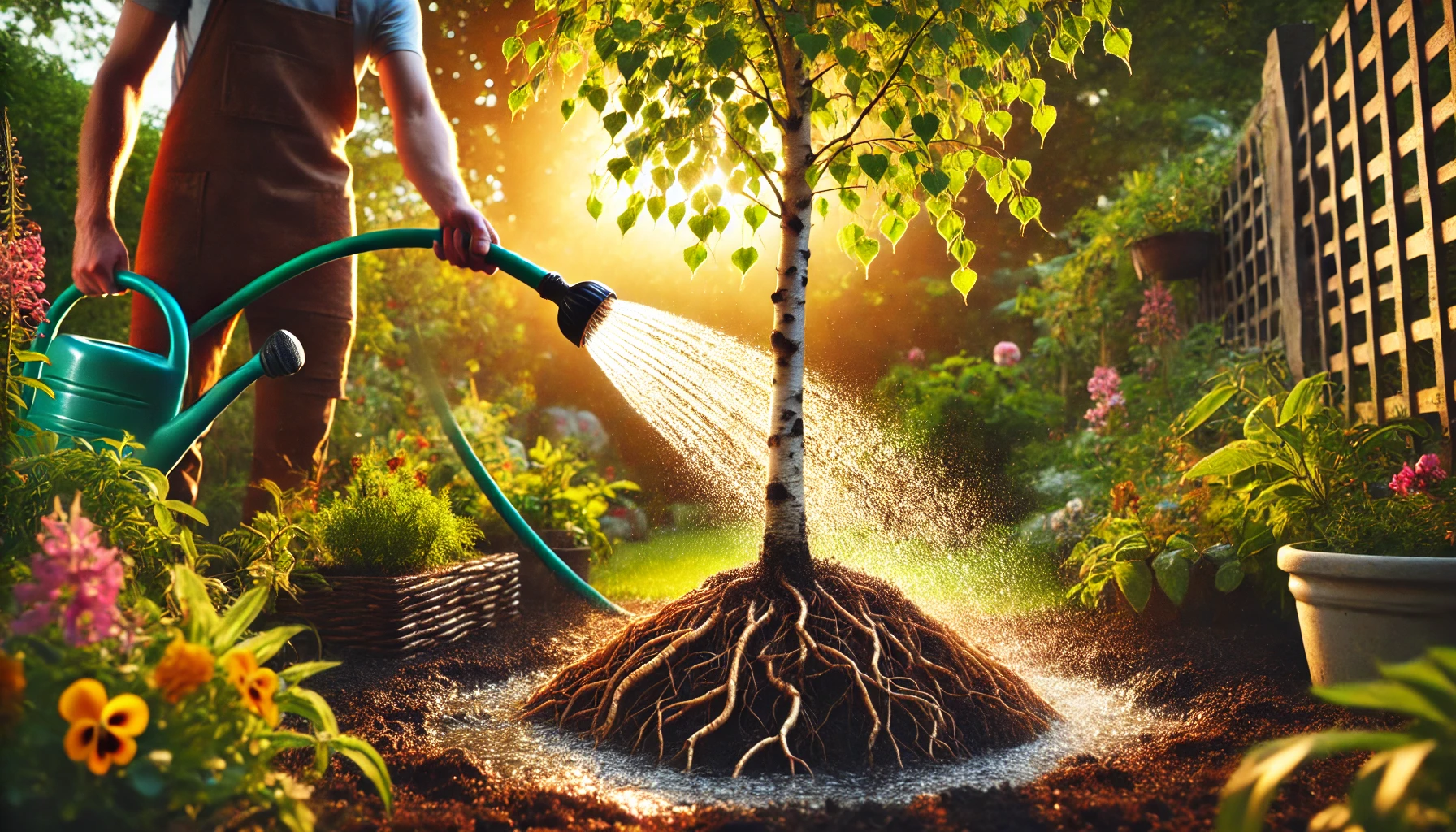
2. How Much Water?
For a young weeping birch, about 5-10 gallons of water per week should be sufficient. As the tree matures, you’ll want to increase the amount of water, especially for larger trees. A mature weeping birch may require up to 15-20 gallons of water weekly. Just ensure the soil is thoroughly soaked without becoming waterlogged.
3. Avoid Overwatering! 
Overwatering can lead to root rot, a common issue for weeping birches. To avoid this, make sure the soil drains well. You can test soil moisture by sticking your finger into the soil. If it feels soggy, hold off on watering for a few days.
4. The Importance of Mulching
Mulch is your best friend when it comes to watering! A 2-3 inch layer of organic mulch around the base of the tree helps retain moisture, keeps the soil temperature stable, and prevents weeds from competing for water. 
5. Seasonal Adjustments 

As the weather cools in fall and winter, your weeping birch won’t need as much water. In fact, during the dormant season (late fall to early spring), you should cut back on watering to prevent the roots from freezing or becoming waterlogged.
By understanding the watering needs of your weeping birch tree, you’ll be able to support its health and longevity. Stick to a regular, deep watering routine and adjust based on the seasons. Your tree will thank you with lush foliage and graceful beauty for years to come!
Fertilizing Weeping Birch Trees: Boosting Growth 
Weeping birch trees are beautiful, graceful additions to any garden, but they thrive best when given the right nutrients. Proper fertilization helps encourage healthy growth, vibrant foliage, and strong roots. If you’re looking to give your weeping birch a little boost, here’s what you need to know.
Why Fertilize Weeping Birch Trees? 
Birch trees, like all plants, require nutrients to grow well. Fertilizing helps replenish the soil with essential elements like nitrogen, phosphorus, and potassium, promoting better growth, more vibrant leaves, and a strong root system. Without these nutrients, your tree might struggle to thrive, showing signs like yellowing leaves or stunted growth.
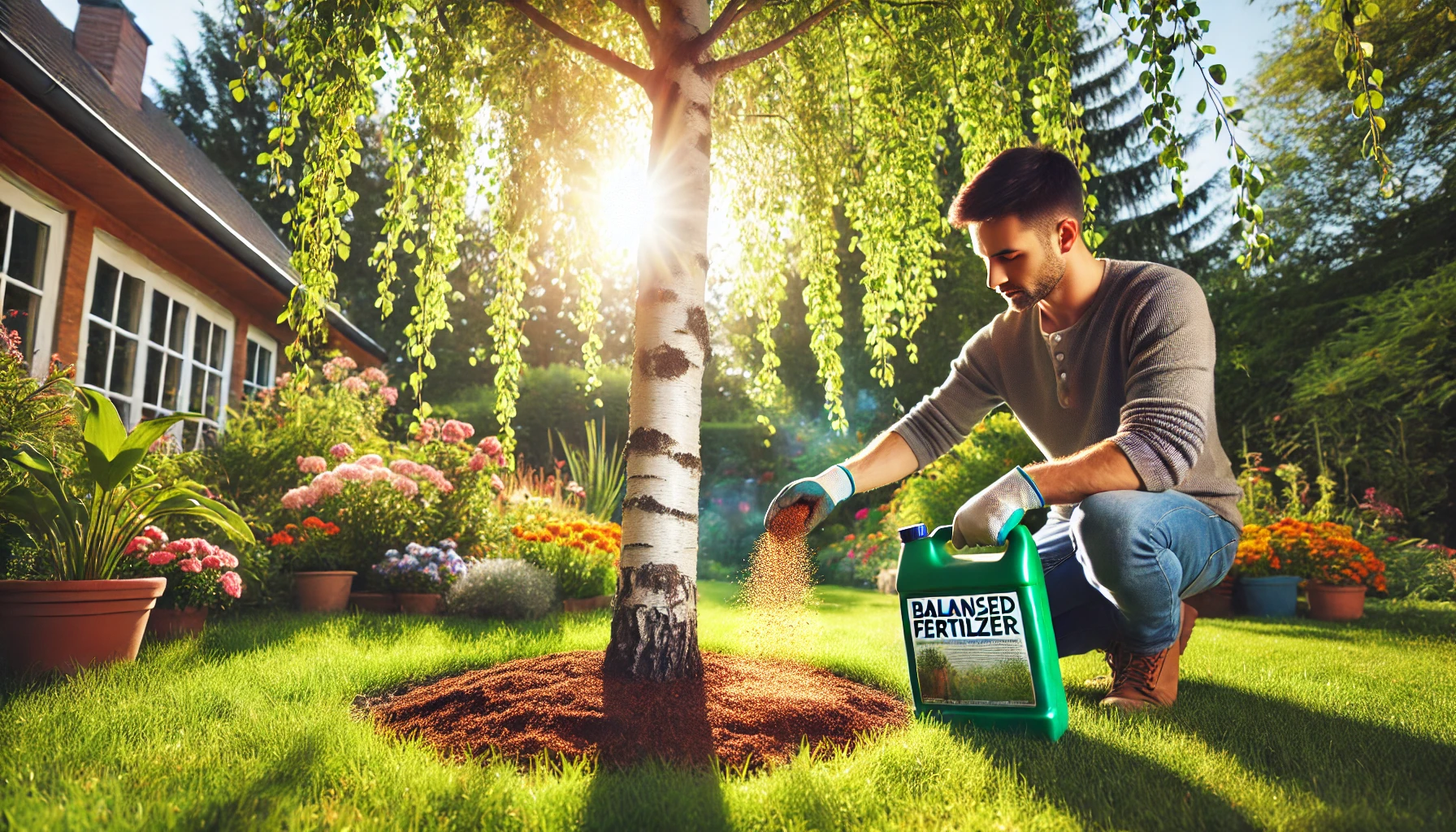
When to Fertilize Your Weeping Birch Tree 
Timing is key when fertilizing weeping birch trees. The best time to fertilize is in early spring, just before the tree starts to show new growth. This gives the tree the nutrients it needs to kick-start the growing season. You can also fertilize again in late spring or early summer if you’re aiming for extra growth, but avoid fertilizing in fall—this can encourage new growth that will be damaged by the cold.
What Type of Fertilizer to Use 
Weeping birch trees prefer balanced fertilizers. Look for a slow-release, all-purpose fertilizer with an equal ratio of nitrogen (N), phosphorus (P), and potassium (K). A 10-10-10 or 20-20-20 formula is a good option. If your soil is lacking in a specific nutrient, you can opt for a fertilizer with a higher concentration of that nutrient (for example, a fertilizer with extra nitrogen if your soil is deficient in it).
Organic fertilizers are another great choice for weeping birch trees, as they improve soil structure over time and provide a steady release of nutrients. Compost or well-aged manure can be worked into the soil to enhance growth naturally.
How to Apply Fertilizer 
Fertilizing weeping birch trees is simple, but it’s important to do it correctly to avoid harming the tree. Here’s how:
- Calculate the Right Amount: Follow the instructions on your fertilizer package. Typically, you’ll apply about 1-2 pounds of fertilizer for every 100 square feet of root zone.
- Evenly Spread the Fertilizer: Sprinkle the fertilizer evenly around the tree, starting about 6 inches from the base of the trunk. Avoid placing fertilizer directly against the trunk, as this can cause damage.
- Water the Tree Well: After applying the fertilizer, water the area thoroughly. This helps the nutrients reach the roots and prevents the fertilizer from burning the soil.
- Mulch for Extra Benefits: After fertilizing, add a layer of mulch around the tree. Mulch helps retain moisture and regulate soil temperature, creating an ideal environment for the tree’s roots.
Signs Your Tree Needs Fertilizer 
If your weeping birch tree is showing the following signs, it might be time to fertilize:
- Yellowing leaves, especially on older branches
- Stunted growth or smaller-than-usual leaves
- Poor root development or shallow roots
- Lack of new growth in spring
Fertilizing in Different Soil Types 
The type of soil in your yard can affect how often and how much you need to fertilize your weeping birch. Sandy soils tend to leach nutrients quickly, so trees in these areas may need more frequent feeding. Clay soils, on the other hand, hold nutrients longer but may require less frequent fertilizing. Always test your soil to get a better idea of what your tree needs.
Common Fertilizing Mistakes to Avoid 
- Over-fertilizing: Too much fertilizer can damage the tree and lead to excessive, weak growth. Stick to the recommended amount.
- Fertilizing at the wrong time: Avoid fertilizing in late fall or winter. The tree is dormant and won’t benefit from extra nutrients during this time.
- Neglecting water: Fertilizer needs water to be absorbed effectively. Make sure to water the tree after application.
By following these simple tips, your weeping birch tree will have the nutrients it needs to grow healthy and strong. Fertilizing is an essential step in tree care that helps your birch thrive through the seasons.
Pruning Weeping Birch Trees: Keeping Them Shaped and Healthy 
Pruning your weeping birch tree is essential for maintaining its health, shape, and overall beauty. With the right techniques, you can encourage strong growth, remove damaged branches, and help your tree flourish year after year. Here’s a step-by-step guide on how to prune weeping birch trees, keeping them vibrant and visually appealing.
1. Timing is Everything 
The best time to prune your weeping birch tree is in late winter or early spring, just before the tree begins to leaf out. During this time, the tree is still dormant, which minimizes stress and promotes quicker recovery. Avoid pruning during the growing season, as it can lead to sap bleeding, which can weaken the tree.
2. Gather the Right Tools 
To prune your weeping birch properly, you’ll need:
- A sharp pair of pruning shears for smaller branches
- Loppers for medium-sized branches
- A pruning saw for larger branches
- Safety gloves and protective eyewear
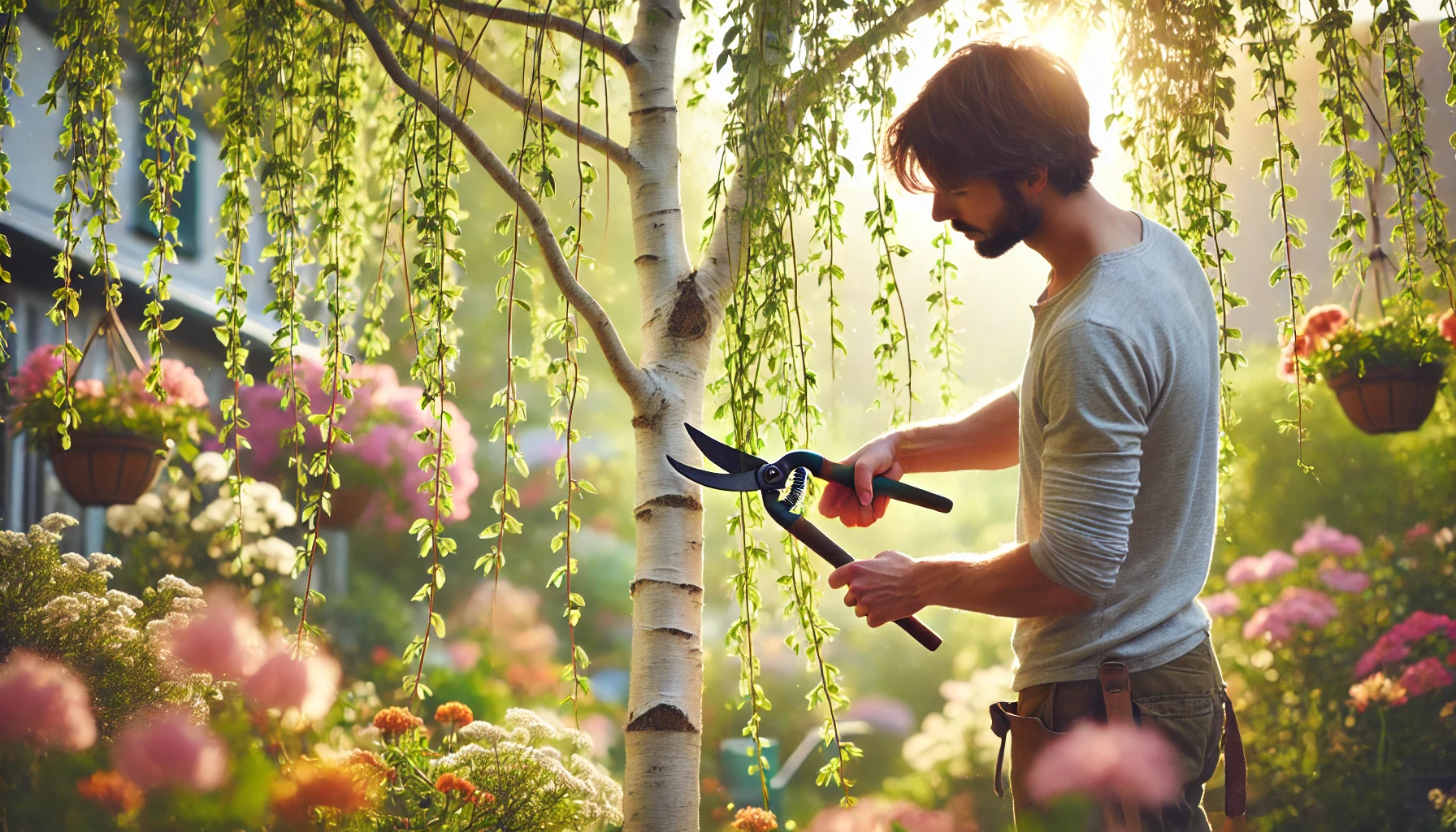
Ensure your tools are clean to prevent spreading diseases between plants.
3. Focus on Dead or Damaged Branches 
Start by removing any dead, diseased, or damaged branches. These can sap the tree’s energy and attract pests. Look for branches that are discolored, broken, or have visible signs of disease. Cut these back to the nearest healthy bud or branch to encourage new growth.
4. Shape the Tree 
Weeping birch trees have a natural, graceful appearance, so it’s important to prune in a way that enhances this shape. Trim any branches that are growing inward or crossing over each other. Focus on maintaining an open, airy canopy to allow sunlight and air to reach the center of the tree. Be careful not to over-prune—leave enough foliage to keep the tree healthy.
5. Remove Suckers and Water Sprouts 
Suckers are the fast-growing shoots that appear at the base of the tree or along the trunk. These should be removed as soon as you spot them, as they can divert energy from the main structure of the tree. Water sprouts, which grow vertically from older branches, should also be pruned to maintain the tree’s elegant drooping form.
6. Make Clean Cuts 
When making cuts, ensure they are clean and angled. This helps the tree heal more quickly and reduces the risk of infection. For branches that are more than 1 inch thick, make a three-cut method:
- First, make a shallow cut on the underside of the branch.
- Then, make a cut on the top side, a bit further out from the first.
- Finally, remove the remaining stub by cutting just beyond the collar (the raised area where the branch connects to the trunk).
7. Step Back and Assess 
After pruning, step back and look at the overall shape of the tree. Does it still have a weeping appearance? Make sure the pruning hasn’t left the tree too bare or uneven. If needed, make a few additional cuts to refine the shape.
8. Clean Up the Area 
Don’t forget to clean up the fallen branches and leaves around your tree. This helps prevent the spread of diseases and pests that may be lurking in the debris. Dispose of the pruned materials properly—composting them can sometimes transfer diseases to other plants.
By following these simple steps, you can keep your weeping birch tree healthy, vibrant, and beautifully shaped year after year. Regular pruning will help you enjoy a lush, graceful tree that enhances your landscape for many seasons to come. Happy pruning!
Common Pests and Diseases Affecting Weeping Birch Trees 
Weeping Birch trees are a beautiful addition to any landscape, but like all trees, they are susceptible to a variety of pests and diseases. Knowing what to look for and how to manage common issues can keep your tree healthy and thriving for years. Here’s a guide to help you spot and deal with the most common pests and diseases affecting Weeping Birches.
1. Birch Borers 
Birch borers are one of the most destructive pests for Weeping Birch trees. These beetles lay their eggs on the bark, and when the larvae hatch, they burrow into the tree, causing serious damage to the inner wood. This damage can result in wilting leaves, yellowing foliage, or even branch dieback.
How to manage:
- Prune and remove affected branches as soon as you notice damage.
- Use insecticidal soap or neem oil to deter borers.
- Consider systemic insecticides if the infestation is severe.
2. Aphids 
Aphids are small, soft-bodied insects that suck sap from the leaves and stems of the tree. This feeding can lead to yellowing leaves, stunted growth, and the secretion of honeydew, which attracts mold.
How to manage:
- Spray the tree with a strong stream of water to dislodge aphids.
- Apply insecticidal soap or neem oil for a more persistent solution.
- Encourage natural predators like ladybugs to help control aphid populations.
3. Leaf Spot Disease 
Leaf spot disease, often caused by fungal infections, results in dark spots on the leaves. Over time, these spots can spread and cause the leaves to fall prematurely, weakening the tree.
How to manage:
- Rake and dispose of fallen leaves to reduce the spread of the fungus.
- Prune any infected branches to improve airflow and reduce moisture around the tree.
- Apply a fungicide in early spring to prevent infection before it starts.
4. Anthracnose 
Anthracnose is a fungal disease that affects Weeping Birches, causing brown, sunken spots on the leaves, and sometimes even premature leaf drop. The disease thrives in cool, wet weather.
How to manage:
- Water your tree at the base, not from above, to keep leaves dry.
- Remove and destroy any infected leaves and branches.
- Use a fungicide labeled for anthracnose to protect your tree during the growing season.
5. Bronze Birch Borer 
This pest is another type of borer that specifically targets birch trees, including Weeping Birches. Bronze Birch Borers cause discolored leaves, thinning branches, and even tree death if not controlled.
How to manage:
- Prevent infestation by avoiding stress to your tree, such as improper watering or poor soil conditions.
- Apply a preventive insecticide in late spring to early summer.
- Remove any dead or dying trees that could harbor the borers.
6. Canker Diseases 
Canker diseases are caused by fungi or bacteria that infect the bark of the tree, leading to lesions and dieback. These diseases often appear after the tree has been stressed or injured.
How to manage:
- Prune away affected areas as soon as you spot them.
- Keep your tree healthy by watering it properly and ensuring it has adequate nutrients.
- Avoid wounding the tree with improper pruning or damage from lawnmowers.
7. Weeping Birch Tree Care Tips 
Maintaining a healthy Weeping Birch tree is the best way to avoid pests and diseases. Here are some general tips:
- Water properly: Birch trees prefer moist, well-drained soil, but they don’t like standing water. Aim for deep, consistent watering.
- Prune regularly: Regular pruning removes dead or damaged wood, reducing the chance of pest infestations and disease.
- Fertilize as needed: Use a balanced fertilizer in early spring to keep your tree strong and resilient.
By staying on top of pest and disease management, your Weeping Birch tree can continue to enhance your landscape with its graceful, drooping branches and vibrant leaves. Regular inspection and care will go a long way in keeping your tree healthy and thriving.
Protecting Weeping Birch Trees in Winter
Weeping Birch trees (Betula pendula) are stunning in any landscape, but their delicate branches and thin bark make them particularly vulnerable during the harsh winter months. To ensure your tree remains healthy and beautiful through the colder season, here are some simple, practical steps you can take to protect your Weeping Birch from winter’s challenges.
1. Wrap the Trunk for Protection 

Birch trees are prone to winter damage, especially from sunscald and frost cracks. Protect your tree’s trunk by wrapping it with tree wrap or burlap. This will shield the bark from extreme temperature swings and prevent cracking caused by the sun’s winter glare. Make sure to wrap the trunk snugly but not too tight, leaving some room for air circulation.
2. Mulch Around the Base 

A thick layer of mulch around the base of the tree can help regulate soil temperature and retain moisture during winter. Use organic mulch like wood chips, leaves, or straw, and apply it about 2-3 inches deep, keeping it a few inches away from the trunk to prevent rot. This insulation helps protect the roots from freezing.
3. Water Before the Freeze 

Ensure your Weeping Birch is well-hydrated before winter sets in. A tree that is stressed due to lack of water will be more susceptible to damage. Water thoroughly in the fall when the ground is still unfrozen. This helps the tree prepare for winter and ensures that it has enough moisture in its system during the cold months.

4. Prune in Late Fall 

Pruning your Weeping Birch tree in late fall (before the first heavy snow) can prevent broken branches from heavy snow and ice accumulation. Focus on removing dead or damaged branches that could easily snap under the weight of snow. Just be sure not to prune too much, as you don’t want to stress the tree during the colder season.
5. Protect from Snow and Ice Accumulation 

While Weeping Birches have drooping branches that can add to their beauty, they are also more susceptible to snow and ice buildup, which can weigh down and snap limbs. If heavy snow or ice is predicted, gently brush off the branches with a broom to avoid damage. If branches do break, prune them back cleanly to prevent any disease from entering the tree.
6. Use Anti-Desiccant Spray 

For added protection, you can apply an anti-desiccant spray to the leaves of your Weeping Birch. This spray forms a protective layer that reduces moisture loss during the winter months, preventing the tree from drying out in the cold, dry air. It’s particularly helpful in areas with harsh winds or extremely low humidity.
7. Monitor for Pests and Diseases 

Winter is a good time to inspect your Weeping Birch for any signs of pests or diseases. Look for holes, discoloration, or signs of insect activity on the bark. While most pests are dormant during winter, some (like borers) may still pose a risk. If you notice any issues, take action early to avoid further complications.
Final Thoughts
With a little effort, you can protect your Weeping Birch from the winter elements and ensure it stays healthy and vibrant for years to come. By wrapping the trunk, mulching the base, pruning carefully, and staying vigilant against pests, you’ll give your tree the best chance of thriving through the winter and beyond!
Troubleshooting: Common Problems and Solutions 
Caring for Weeping Birch trees can be a rewarding experience, but like all plants, they sometimes face challenges. Below are some of the most common problems you might encounter and practical solutions to help keep your tree healthy and thriving.
1. Yellowing Leaves 
Problem: If the leaves of your Weeping Birch are turning yellow, it could be a sign of nutrient deficiency, overwatering, or poor drainage.
Solution:
- Nutrient Deficiency: Ensure your tree is getting the right amount of nitrogen, which is vital for leaf health. You can apply a balanced, slow-release fertilizer in the spring.
- Watering Issues: Make sure you’re not overwatering! Weeping Birches prefer moist but well-drained soil. Water only when the top few inches of soil are dry.
- Improved Drainage: If the soil doesn’t drain well, consider aerating the area around the tree or adding organic matter like compost to help with water flow.
2. Wilting Leaves or Tree Decline 
Problem: Wilting or drooping leaves, especially during hot months, may indicate stress from lack of water, pests, or root damage.
Solution:
- Watering: Increase watering during dry spells, ensuring the soil stays moist but not soggy. Deep watering is key.
- Pest Check: Inspect the tree for common pests like aphids or borers. If you spot any, treat with an insecticidal soap or neem oil.
- Root Care: If you suspect root damage, avoid compacting the soil near the roots and make sure the tree has enough space to grow.
3. Brown Spots on Leaves 
Problem: Brown spots or edges on the leaves are often a sign of fungal infections or leaf scorch due to sunburn.
Solution:
- Fungal Diseases: Remove and discard any infected leaves to stop the spread of fungi. You can also treat with a fungicide to protect the remaining foliage.
- Leaf Scorch: If sunburn is the culprit, try relocating the tree to a spot with some afternoon shade or provide temporary shade during the hottest part of the day.
4. Cracked or Damaged Bark 
Problem: Cracks or wounds on the bark may appear due to weather changes, poor care, or pests.
Solution:
- Protecting the Tree: During winter, wrap the trunk with tree wrap to prevent frost damage. In summer, make sure the tree is not stressed by drought or extreme heat.
- Pest Prevention: If you spot any insect activity around the damaged areas, treat with appropriate pest control measures.
5. Leaf Drop Prematurely 
Problem: Dropping leaves earlier than usual can be a sign of stress due to environmental factors, disease, or pest infestation.
Solution:
- Environmental Stress: Check for extreme temperature fluctuations, drought, or soil compaction around the tree. Adjust care routines to stabilize conditions.
- Pest Control: Look for insects or fungal diseases that could be causing leaf drop. Proper treatment with insecticides or fungicides can help protect the tree.
6. Weak Growth or No New Growth 
Problem: If your Weeping Birch isn’t growing as expected or seems stagnant, it may be struggling with soil quality or lack of sunlight.
Solution:
- Soil Quality: Conduct a soil test to check for nutrient imbalances. Add compost or organic material to improve soil fertility.
- Sunlight: Weeping Birches prefer full sun to partial shade. Ensure the tree is getting enough sunlight each day, especially during the growing season.
By being proactive and following these easy troubleshooting tips, you can help your Weeping Birch thrive and avoid many common issues. Happy gardening!
Conclusion 
Caring for a Weeping Birch tree can be a truly fulfilling experience when you know how to address common challenges and provide the right environment. With the tips and solutions outlined above, you’ll be better equipped to maintain a healthy, vibrant tree that thrives year after year.
Remember, regular monitoring, proper watering, and the right amount of sunlight are key to a Weeping Birch’s success. By staying proactive with care and troubleshooting any issues promptly, you’ll ensure your tree continues to grow beautifully and live a long, healthy life.
Happy gardening, and enjoy the elegance and beauty of your Weeping Birch!
Frequently Asked Questions(FAQ)
How often should I water my Weeping Birch tree? 🌊
Weeping Birches prefer consistently moist soil, but they don’t like to be waterlogged. Water your tree deeply once a week, especially during hot, dry periods. Ensure the top few inches of soil are dry before watering again to avoid overwatering.
What type of soil is best for Weeping Birch trees? 🌱
Weeping Birches thrive in well-drained, slightly acidic soil. Loamy or sandy soil works best, as it allows water to drain while retaining enough moisture. Avoid heavy clay soils, which can trap water and harm the roots.
Why are the leaves on my Weeping Birch turning yellow? 🍂
Yellowing leaves may indicate a nutrient deficiency, especially a lack of nitrogen. It can also be caused by overwatering, poor drainage, or pests. Check the soil moisture and consider adding a balanced fertilizer to boost nutrients.
Can I prune my Weeping Birch tree? ✂️
Yes, pruning is essential for maintaining the shape and health of your Weeping Birch. It’s best to prune in late winter or early spring when the tree is dormant. Remove dead or damaged branches, and shape the tree as needed, but avoid heavy pruning.
How do I prevent pests on my Weeping Birch? 🐞
Common pests like aphids and borers can harm your Weeping Birch. Inspect the tree regularly and treat infestations with natural insecticidal soap or neem oil. Keeping the tree healthy with proper care will also make it more resistant to pests.
Why is my Weeping Birch tree losing its leaves early?
Early leaf drop can be caused by stress factors like drought, disease, or pest damage. Ensure the tree is getting enough water, especially during dry spells, and check for pests or fungal infections. Addressing the underlying issue will help prevent further leaf loss.
How can I protect my Weeping Birch from winter damage?
In winter, Weeping Birches can suffer from frost damage and sunscald. Wrap the trunk with tree wrap to protect it from temperature fluctuations. Mulching around the base of the tree helps insulate the roots and keeps the soil from freezing.
How fast do Weeping Birch trees grow?
Weeping Birch trees are relatively fast-growing and can add 1 to 2 feet of height per year under ideal conditions. With proper care, they can reach a mature height of 30 to 50 feet, making them a great choice for landscaping and shade.



